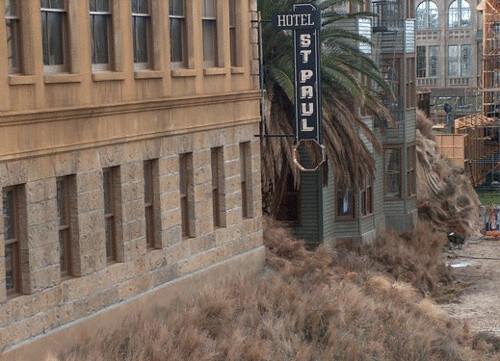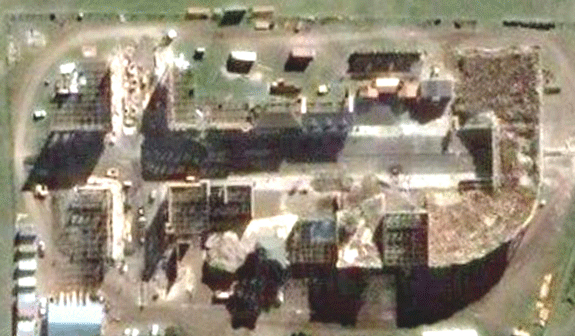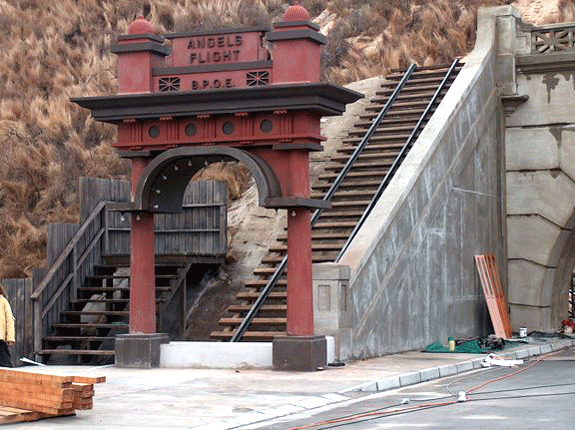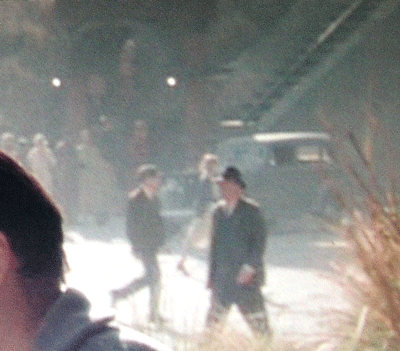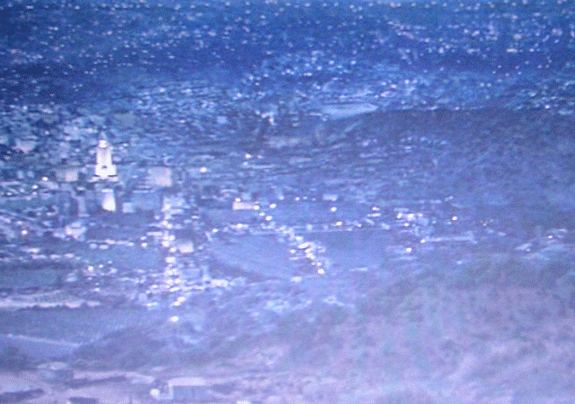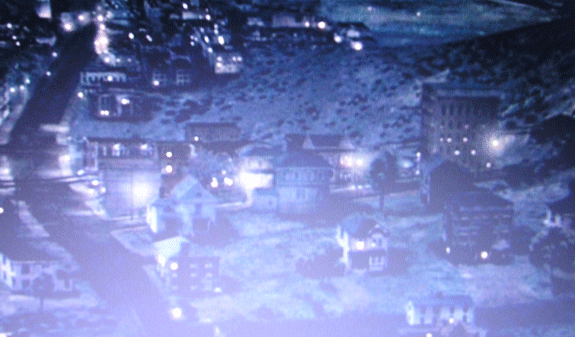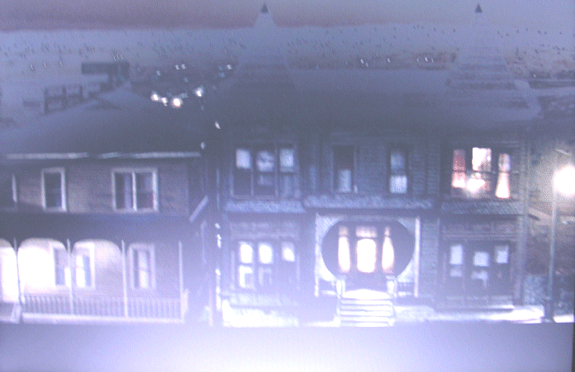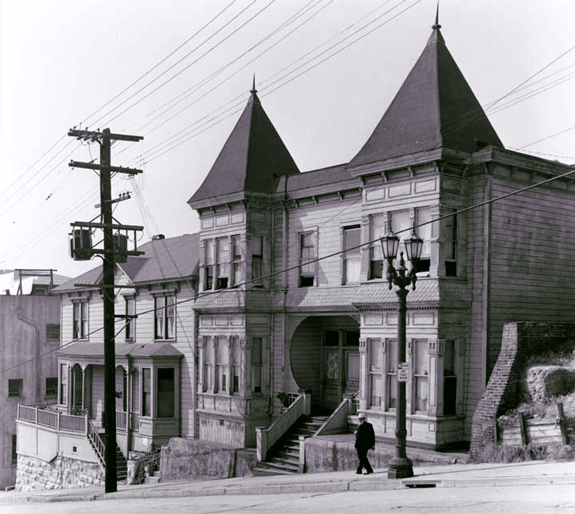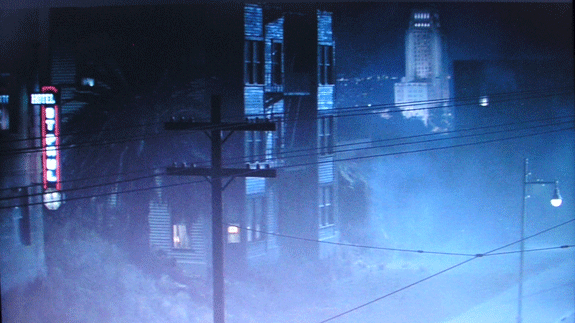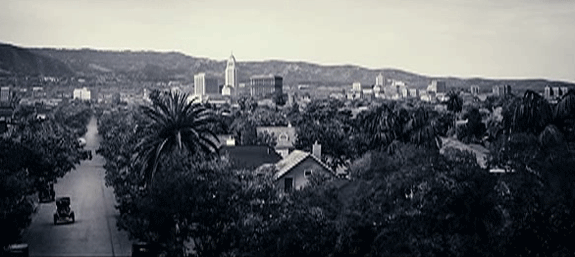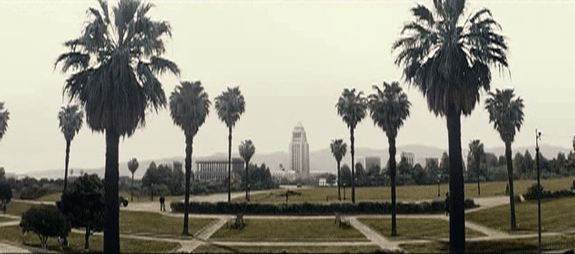John Fante, Los Angeles Times, 1950
I used to live on Bunker Hill. It was my first home in this incredible city. That was in 1932, a time of dreams for me, and of poverty. I had a typewriter and a stack of white paper, and I had my room in a hotel on Bunker Hill.
It cost me $3 a week, that little room, a fabulous sum in those lean days, but I wish I might do it over again, sit in my lilttle room with its worn green carpet, sit there in the high, old-fashioned rocker, eating an orange, my feet on the window, feasting my eyes on the city below. Such dreams for a man! A whole afternoon with the sun pouring down, a whole evening under white, chunky stars. “This is the place,” I used to gasp, “I shall never leave here.”
I never did very much work in those days, never finished more than a short story. It held me, that mysterious little room with its startling view, that lonely Bunker Hill with its ancient buildigns, its quiet streets and lonely trees with here and there a bright spot from which came the scent of singing hamburgers, the crooning voice of Bing Crosby, the soft sound of men speaking and laughing. I remember the cool afternoons, the city below, a film of carbon monoxide choking it, the deep moaning of traffic within the Third St. tunnel, the high frightened squeal of the cable car lurching up Angels”™ Flight.
I was highter than the City Hall, higher than the Biltmore, higher than the Richfield Tower. It was paradise. I couldn”™t work. I was drugged in dreams, steeped in teh fascination of old houses and gentle eucalyptus trees growing out of the green slopes there on the west side of Bunker Hill. SOmetimes I went down to the library and got a book, some poetry maybe, some gentle and persuasive book, something to read on the hillside, something to put me to sleep under the eucalyptus trees.
Tetsu Hagamore, what has happened to him? He isn”™t there now, but in 1932 that wonderful Tetsu had a grocery store at Third and Flower. he used to see me coming, his black eyes laughing as he reached for a big paper sack. Lean days for me sometimes only a nickel a day for food. The old man understood, nodding his head: in Tokyo he had an uncle who was a writer, too. Tough town, Tokyo. Tough for writers. So, Chasso, Verrie, verri tough. Chasso. And Tetsu”™s bullet-shaped head bent over the fruit stall: always the same five-pound sack, Tetsu filling it with apples, oranges and bananas. Sometimes I had a dime, sometimes 15r cents. No matter to Tetsu, he always filled the sack. Once he saw me circle his store on the other side of the street. Not even a nickel that day. Tetsu called me. “Chasso,” said Tetsu. “Uncle in Tokyo. Him stahve, too. No gottem nickel. So. Chasso. Taken fruit. So. Takem. Pay rater. So. Thank you so much.”
And the day was saved.
Fruit, fruit, fruit. Apples for breakfast. Oranges for lunch. Bananas for dinner. I used to sit with my feet over the window, watching the city”™s lights bursing in the green twilight, my lap piled with banana skins and orange peels. But I liked it, waiting for the darkness, waiting for the night and a prowl through the dismal effugence of Main St. and lower Fifth St. Down the eternal stairs of Angel”™s Flight to Hill St. and the blazing inferno below. Down to the Plaza. Down to Chinatown and Olvera St. Down to the jungled bitterness of lower Fifth St., drinking it down, gulping it down, the wild, beautiful, terrible city. The midnight and the slow pull up the steep stairs of Angel”™s Flight, counting the stairs just for the fun of it, always getting mixed up after a hundred, happy to reach my hotel, grateful for the hard bed in my little room, its sheets so worn and thin you saw the striped mattress beneath. And there to lie and watch the neon lights jumping red and blue across the foot of the bed, my head whirling with a jumble of panting sensations. Gala days, those Old Buniker Hill, I loved you then!
Strange people in that hotel. Strangers from Ohio, from New York, from Indiana. Suspicious folk, lonely folk, hating their suspicion, eager to quench their loneliness, but afraid, afraid. Or what? they didn”™t know. They had been warned: Los Angeles, bad, be very careful of strangers.
I used to sit on the porch and watch them in the evenings as they returned from the roaring city below. Their eyes were startled, their mouths open, their breaths coming hard after the steep climb. Gratefully they threw themselves into porch rockers and gazed in confusion at the mysterious sky. The quiet hill relaxed them, the swishing, palms told them they had returned to their earth again, back from the crazy whirl below. Their limbs san with gratitude for Bunker Kill, the softness of children filed their harried eyes.
I knew a few of them. Mr. H. lived next door. “H.,” retired from the Army with a meager pension, had scarcely enough money to pay his liquor bills. Often poor H. had to abstain from gin three and four days a month. He was so miserable there in his room, always naked under a gray bathrobe that showed hair and bones beneath, stumbling barefoot through a litter of empty gin bottles, forced to survive on cheap wine until the next check arrived. At night I could hear him in bed, tossing and groaning, smoking cigarettes and scratching matches savagely against the wall, denouncing his life, the government, the earth, mankind and particularly the lousy wine which clucked his throat like a hen.
On the other side was Mrs. C., a widow, tall, gaunt, ferocious, uncommunicative, not even a nod when you met her in the hall and said hello. She has come from Battle Creek, Mich., and she was the oldest guest in the hotel, having lived in the same room for 22 years.
Occasionally I saw the inside of Mrs. C”™s room, especially in the hot, afternoons, when she opened the door for the cooling draft. It made you gasp. To the very ceiling it was piled with boxes and trunks and old newspapers. What one saw of the walls was covered by Hy-specked daguerreotypes in heavy gold frames, pictures of men and women long deal, their grim faces defying complete obliteration.
Mrs. C.”™s key box was beside mine behind the clerk”™s desk. In all the months I lived there I never saw Mrs. C. get a letter. But every afternoon her mail box contained a new piece of mail: The Battle Creek News. Half of her room was piled to the ceiling with back numbers.
And there was the lad named Cross, who washed dishes at Bernstein”™s, and dreamed of the day when there would be money enough to return to Sydney, Australia. He had to have a stake. he had to return home with the appearances of a rich young man. It was his plan for vindication, for he had run away from home three years before and had got himself into serious trouble with his folks, writing them that he was a big executive in the lumber business.
And Jullo, the Filipino, a bellhop at the Biltmore who wrote novels in his spare time, wrote novels with the facility of a boy scrawling his name on a back fence. Julio, the pest, who wrote a couple of novels a month and brought them to me for criticism. And Elaine, the shady, lovely Elaine, who arrived quietly at night and for two weeks had the hotel humming like a beehive with gossip; Elaine, who did a grand business around there, until the landlady found out and ordered her to leave.
And Leon from San Francisco, always shouting in the lobby, denouncing Los Angeles endlessly, praising San Francisco with such fury no one dared dispute him. And Miss L., always draped in black, her small, white lips perpetually smiling, so that the smile gradually became somewhat sinister: Miss L, always scurrying to the library and returning with an armload of theosophic books. Miss L., was a student of palmistry and card reading. She claimed a great knowledge of dogs and pets, but one day the landlady”™s wirehaired terrier come down with distemper and Miss L went screaming down the halls, shouting, “Run for your lives! Run for your lives!” She believed distemper brought influenza and tuberculosis to humans, and they had a hard time quieting her. She locked herself in her room and sprinkled the walls and carpets with lysol. For weeks he held our noses as we passed her door.
The dream of Miss L.”™s life was to set up a little parlor where, for small sums, she could read palms, coffee cups, tea leaves and head bumps. The loafers int he lobby had some curious interpretations of Miss L.”™s strange machinations, but they are unprintable.
But they are gone now, these people scattered like dust. Everything changes, and for better or worse the change came for me, and the years have trickled away, and Bunker Hill is only a memory. But it lives on. It gave my thought food and drink, It sated myh hunger for life, despite the harsh rigors of straight, fruit diet during those heroic months.
Everything changes, and now Bunker Hill faces change. It seemed timeless, and now they are putting it away. The papers carry the story; the old Bunker Hill must go. The old hotels, the brave palms, the quiet streets- away with all of them! They are going to tear Bunker Hill down, or build it up, or wipe it out, or something. It hurts me. I set my lips and inhale my cigarettes and smile. Those precious months! Those tender nights! How shall I mark them? Where shall I go to find their souvenirs?
They are changing Bunker Hill, yes, but in my heart the palms sigh, the little plots of grass on the slopes remain forever green and a boy”™s kite lies helplessly entangled in the branches of a brave eucalyptus tree.

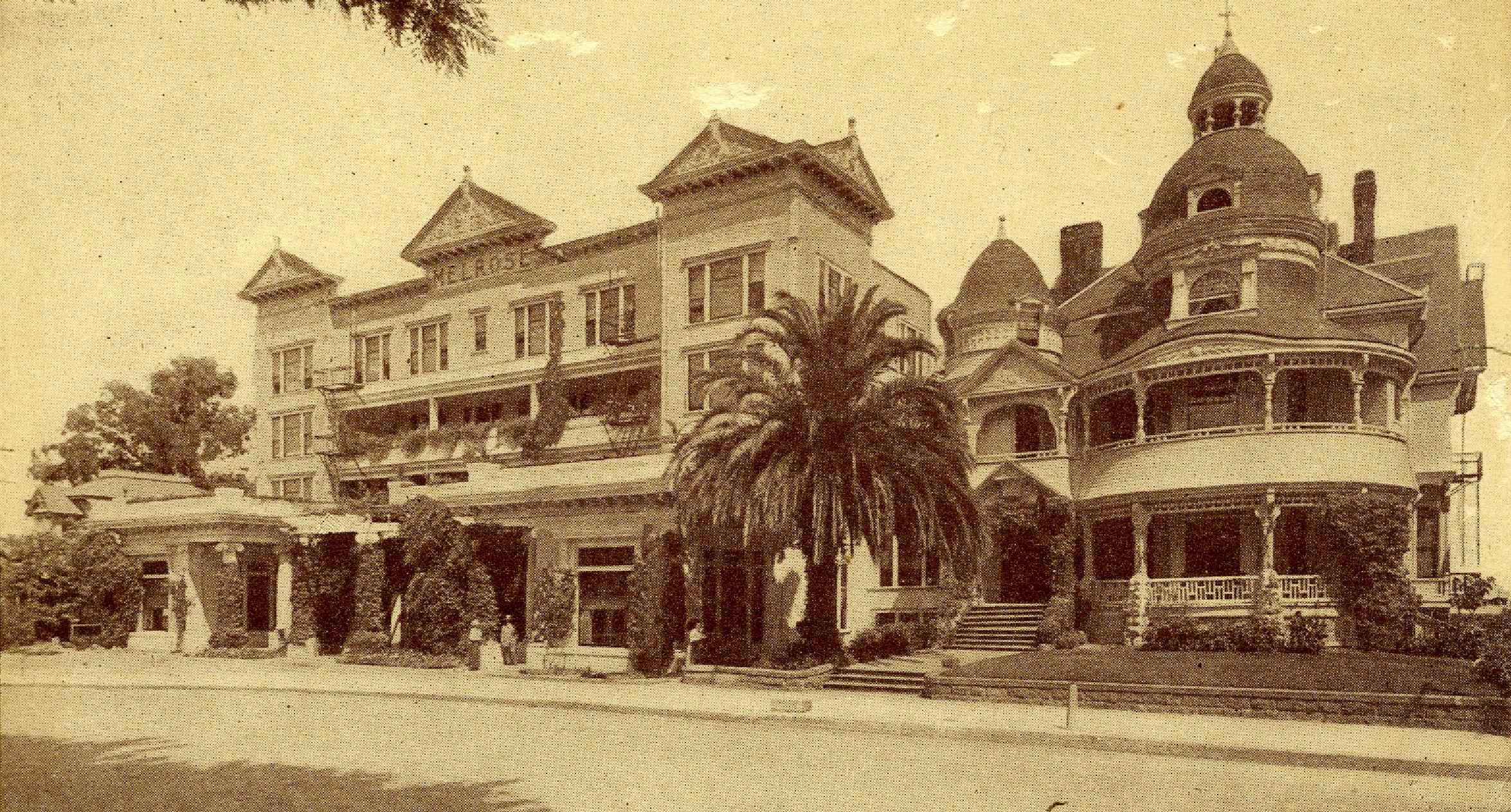
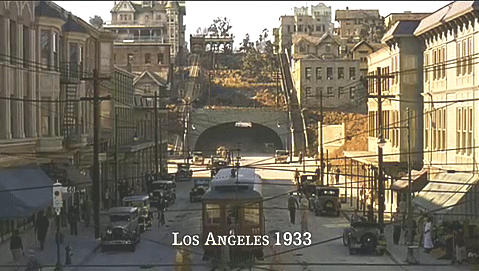
 Bunker Hill of old is gone, never to be again. Until we concoct some Disneyesque Colonial Williamsburgian simulacrum, complete with sullen teenagers hired to pose as grimy grifters, we‘ll never be able to amble down Third toward Hill and catch Angels Flight up to battenboard and gingerbread. (Imagine, the collapse of the Vanderbilt will be repeated at two, four, and six! Visit the souvenir stand outside the Elmar! We gotta get Eco on board. Dang, too bad Baudrillard just died.)
Bunker Hill of old is gone, never to be again. Until we concoct some Disneyesque Colonial Williamsburgian simulacrum, complete with sullen teenagers hired to pose as grimy grifters, we‘ll never be able to amble down Third toward Hill and catch Angels Flight up to battenboard and gingerbread. (Imagine, the collapse of the Vanderbilt will be repeated at two, four, and six! Visit the souvenir stand outside the Elmar! We gotta get Eco on board. Dang, too bad Baudrillard just died.)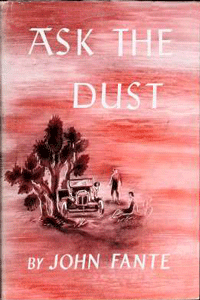 What is this Asking of Dust, you ask? Fine, a little background. It‘s the 1930s, and while the world was awash in novels of the mannered drawing-room variety, aspiring writer John Fante was banging out gritty realism, as best he could, considering that at every turn he‘d find the “mechanism of [his] new typewriter glutted with sand.” This is the titular dust, the tiny brown grains that‘d blow in from the Mojave, that‘d get in his hair and ears and find its way into the bedsheets of his little room at the Alta Loma, his Bunker Hill flop.
What is this Asking of Dust, you ask? Fine, a little background. It‘s the 1930s, and while the world was awash in novels of the mannered drawing-room variety, aspiring writer John Fante was banging out gritty realism, as best he could, considering that at every turn he‘d find the “mechanism of [his] new typewriter glutted with sand.” This is the titular dust, the tiny brown grains that‘d blow in from the Mojave, that‘d get in his hair and ears and find its way into the bedsheets of his little room at the Alta Loma, his Bunker Hill flop. 
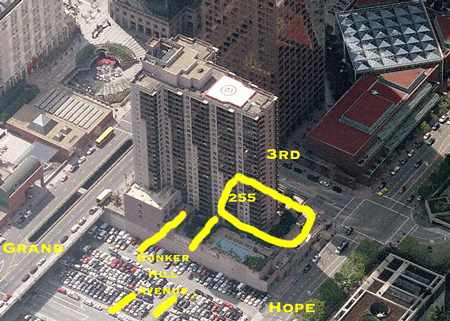
 I may only know the bare minimum about making period pictures, but at least it‘s something. Ten years ago, Richard and I–Kim‘s Richard, builder of this blog–were the art department for “indie” film
I may only know the bare minimum about making period pictures, but at least it‘s something. Ten years ago, Richard and I–Kim‘s Richard, builder of this blog–were the art department for “indie” film 
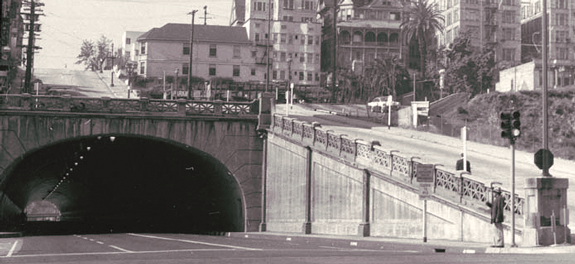
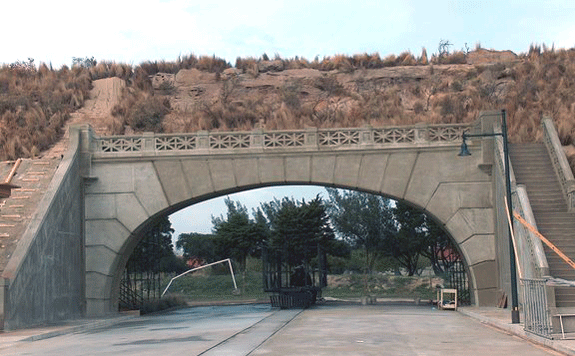
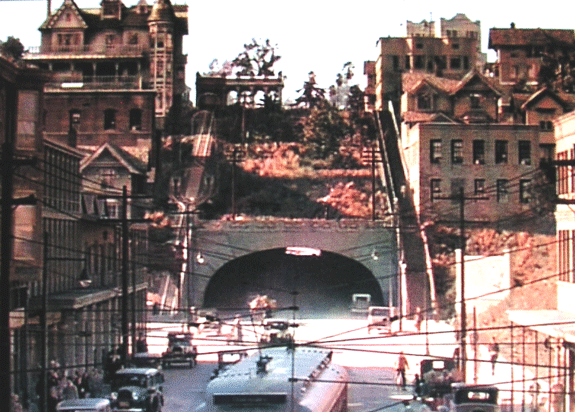
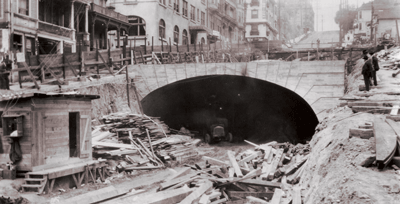

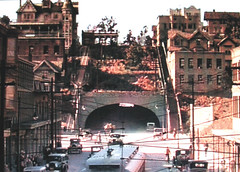
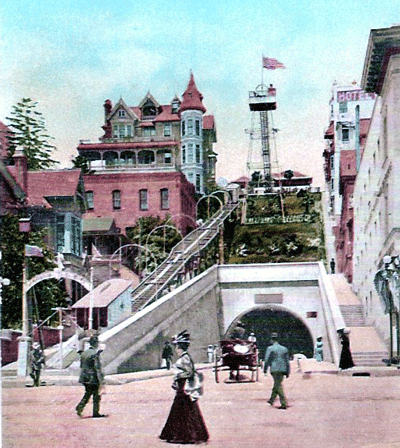
 What I find really intriguing in Ask the Dust‘s interpretation is the inclusion of the six-bay arched entry to Angels Flight, up top on Olive Street (you can see four of the open bays because the two on the left were closed in for the ticket booth). This pavilion would naturally butt up against the Hillcrest, but because the tunnel below is now so wide, there exists this odd empty area. The six-bay pavilion up top also thrusts us into an all the more peculiar place within the time-space continuum; it only existed between 1910 and 1914. While the Crocker Mansion existed before 1908. And the here-absent Observation Tower was not removed until 1938, five years after the Ask the Dust shot was “taken.”
What I find really intriguing in Ask the Dust‘s interpretation is the inclusion of the six-bay arched entry to Angels Flight, up top on Olive Street (you can see four of the open bays because the two on the left were closed in for the ticket booth). This pavilion would naturally butt up against the Hillcrest, but because the tunnel below is now so wide, there exists this odd empty area. The six-bay pavilion up top also thrusts us into an all the more peculiar place within the time-space continuum; it only existed between 1910 and 1914. While the Crocker Mansion existed before 1908. And the here-absent Observation Tower was not removed until 1938, five years after the Ask the Dust shot was “taken.”
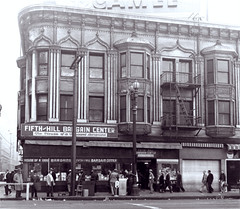
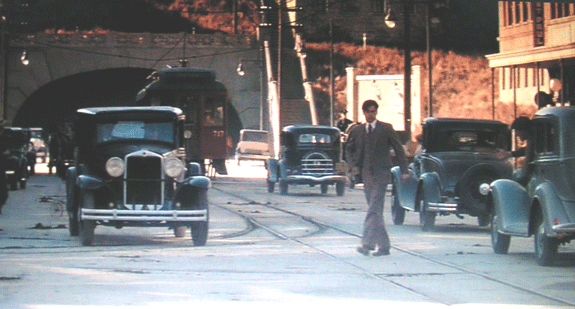
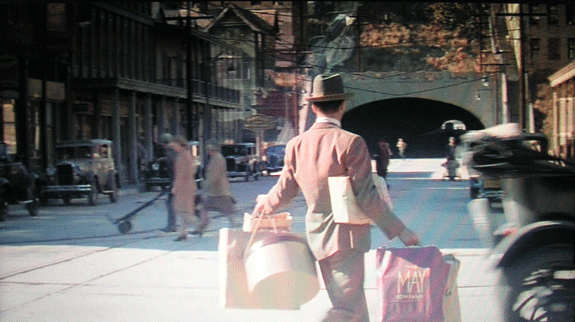
 What‘s also interesting is that Bandini doesn‘t actually live on Bunker Hill. The Alta Loma slopes down to Hill Street, in the middle of the 300 block–to the right of the St. Paul neon.
What‘s also interesting is that Bandini doesn‘t actually live on Bunker Hill. The Alta Loma slopes down to Hill Street, in the middle of the 300 block–to the right of the St. Paul neon.